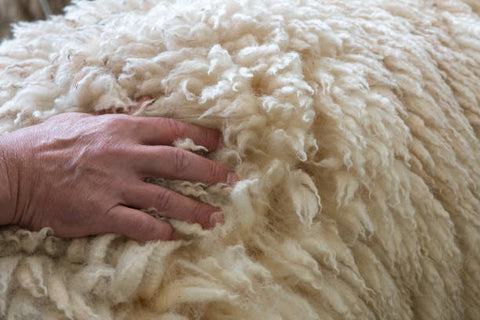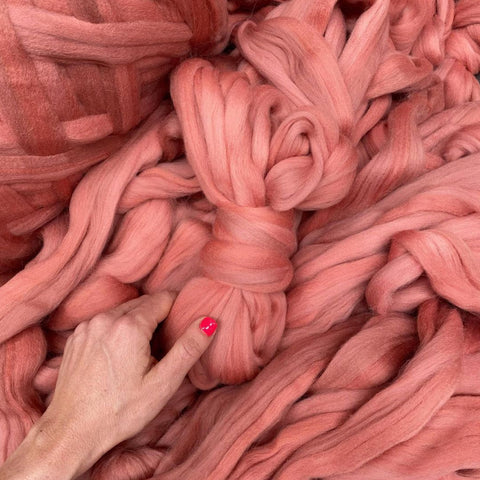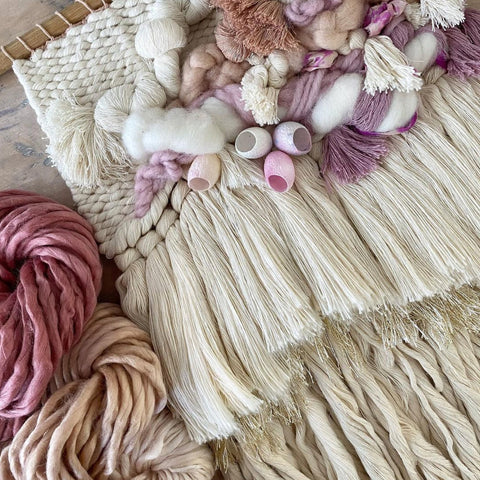- Sale
- New
-
Kits & Patterns
-
Macrame
-
Weaving
-
Shop by Fibre
-
Tools
- Gift Cards
- Blog
- Subscribe
-
March 09, 2022 0 Comments
Whether you're a knitter or a knotter, you've no doubt used wool yarn at some point in your creative life... or you’re about too! It's useful across all fibre art disciplines due to its long and strong nature, it’s incredible versatility and most notably, the variety of colours and thicknesses it is available in. Most of the yarn you find in stores today is mass produced on industrial equipment, whilst there is nothing wrong with this kind of yarn (it is efficient, and it yields consistent results, which is exactly what you want for some projects) It’s great to dive a little deeper into the luscious fibres that are destined to make your handmade creations pop… hand spun, hand made yarn. Ohh how we love the, and ohh how it will change your world!
There are an abundance of small independent and family farms who are dedicated to processing their own fleece, so you get to support small businesses whist taking advantage of their divine, consciously crafted products. From fleece to fibre, all steps in production are facilitated by small handmade communities and Artists just like you – who love fibre and the joy of the journey… not just the finished product (albeit it stunning!)
Fleece Animals:
The very first step in the yarn making process is taking really good care of the animals. Happy healthy animals, those which are loving cared for are not only healthier but happier, and we think this matters to produce the softest, longest fleece imaginable.
The most common fleece animals are sheep, alpacas, and goats. Each requires a different level of care and owners must be tuned to their specific needs. Visit any small livestock farm and you’ll see just how much love and attention these animals receive. They get lots of nutrient rich food and plenty of space to frolic and graze to their heart's content. Farmers often hold special energic connections to their animals and if you are to every visit a small farm you will experience this relationship first-hand. Think Dr Doolittle, talking to the animals is definitely a regular occurrence.
Breeding is vital part of producing high quality fleece. With alpaca fleece, for example, you want lots of crimp (the natural wave of each fibre), high density (the number of individual fibres packed into a small area) and minimal guard hair (the longer, coarse hairs that grow among the fleece). Lighter colours like tan and grey are typically preferable because they take on dye more easily. These features are genetic, so alpaca breeders must carefully select which animals to breed to produce the nicest fleece.
Shearing:
When fleece is long enough, it’s time for shearing. Most animals are shorn once a year in the springtime, after they've spent all winter under their cosy fleece blanket. It's important to shear fleece bearing animals regularly. Their hair grows continuously, and it can get matted if it gets too long, which can restrict movement and cause other health problems. Plus, a spring haircut helps keep them cool for the summer. Imagine wearing a jumper mattered in summer- no thanks... they’d be uncomfortable, miserable and defiantly not producing their best wool!
The fleece from the animal’s back is called “firsts” because it’s the highest quality. It’s also sometimes called the blanket. It grows long and dense, so it’s ideal for turning into yarn. The short, coarse fibres that grow on their legs, stomach, and neck are called “seconds” and the super short stuff is called “thirds”. While seconds and thirds aren't very good for yarn, they don’t go to waste. They get used for things like bird nesting boxes, toe stuffers, and felting.
The shorn fleece is stored in a cool, dry place so that it doesn't mould while it waits to be processed. This is when the owner will decide which fleece to process by hand and which to send off to a mill. It all depends on what projects they have in mind and how much time they have to dedicate to the raw fleece.

Cleaning and Skirting:
Any fleece the owner decides to keep must then be cleaned. Thoroughly. Sheep’s wool contains lanolin, which is a waxy substance that helps keep the sheep dry. Lanolin can be removed with special soap, or it can be left in for an extra strong, if not slightly scratchier yarn.
Most fleece does not need to be washed, though, and using harsh soaps can leave it dry and brittle just like human hair. It is naturally dirt repellent, so all it needs in the way of cleaning is a good shake. No, seriously! Each blanket gets put on a big wire rack called a skirting table and shaken back and forth so that all the dust, dirt, and super short hairs fall through. Then, it gets picked over to remove any larger debris that might be stuck in it. It’s a time staking process but it’s well worth it if you are wanting the best – which of course we do!
Carding:
Once the fleece is nice and clean, it goes through a process called carding. This is where all the individual strands of fleece are combed through to lie in the same direction. For smaller batches this can be done with a fibre brush by placing the fleece in between and dragging the brushes in opposite directions several times.
Another option is a drum carding machine. These are much larger than brushes so they can process more fleece at once, and they come in both hand crank and electronic varieties to save even more time. The concept is the same as with the brushes, but instead of two paddles the machine uses two spinning cylinders covered in wire bristles, one larger and one smaller. The fleece is fed in under the smaller roller and the machine pulls it up between the two rollers to gather on the larger one.
Once the drum fills up, the fleece is pulled apart at the seam and removed from the carder. This is called batting, and it's an incredibly versatile form of fleece. It can be used for hand spinning, needle felting, stuffing, adding texture to embroidery, and much more. Batting can be turned into roving by reshaping the rectangle into a long narrow strand. We offer a range of roving in a variety of lovely colours here that have all undergone this process. You can use it in its raw form or follow the below to create your own magic.
Spinning:
From there, the fleece gets spun into yarn. There are a couple different ways to hand-spin yarn. The most common is a spinning wheel, which is usually powered by a foot pedal. A more portable option is a drop spindle, which has been in use for most of human history. The roving is pulled to the desired thickness and twisted in one direction to create a strong strand of yarn. The first go-through makes a single ply yarn. For two and three ply yarn, several single ply strands are twisted together to create the type of yarn you typically use for weaving, macrame and knitting.
The last step in the process… you!
After that, the yarn is wound into skeins and it's ready to be used for any number of creative Fibre Arts. That's where you come in! Whether you use it within your woven tapestry or turn it into a woven scarf, we know your final project is made all the more special by using handmade, heartfelt conscious materials.
Inspiring, isn’t it? Whilst most of us cannot go and start our own hobby farm tomorrow we sure can support those who have. We work closely with our farmers to ensure the best so you can create magic with their fibres, have you used our roving and drop spindles in your fibre practice.
We would LOVE to see!

October 06, 2022 0 Comments
May 02, 2022 0 Comments
March 21, 2022 0 Comments
